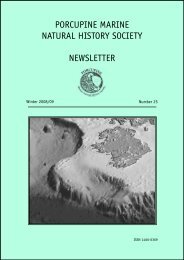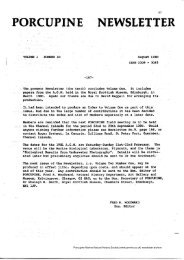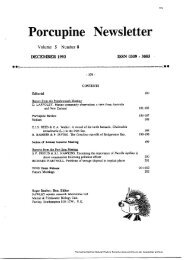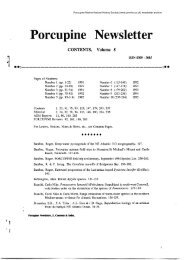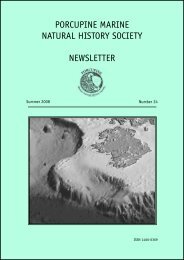Porcupine Newsletter - Porcupine Marine Natural History Society
Porcupine Newsletter - Porcupine Marine Natural History Society
Porcupine Newsletter - Porcupine Marine Natural History Society
Create successful ePaper yourself
Turn your PDF publications into a flip-book with our unique Google optimized e-Paper software.
for which nuclear and mitochondrial gene<br />
sequences are available.<br />
Generally, in the study of Nezumia, it<br />
was much more difficult to perform molecular<br />
investigations because of the very damaging<br />
effect of formalin on the quality and yield<br />
of extracted DNA, as well as the absence of<br />
existing molecular information. The first<br />
molecular data on Nezumia aequalis and N.<br />
micronychodon were produced, and validated on<br />
additional formalin-fixed, DMSO- and ethanolpreserved<br />
samples. Specific PCR primers were<br />
designed, and reproducible DNA sequences<br />
were submitted to the GenBank nucleic acid<br />
database under accession numbers: AY826774<br />
– AY826792.<br />
The second study, with mackerel, involved<br />
determining the most appropriate protocols for<br />
DNA extraction from tissues exposed to the<br />
different preservatives, and testing the success<br />
of PCR amplifications against known targeted<br />
nuclear and mitochondrial sequences.<br />
The results of these studies were presented<br />
and recommendations about approaches<br />
made.<br />
Regional Collection<br />
Planning for Lower<br />
Vertebrates and<br />
Invertebrates<br />
Brian Zimmerman<br />
Zoological <strong>Society</strong> of London, Regent’s park,<br />
London NW1 4RY<br />
Zoos and public aquariums have<br />
traditionally planned their collections based<br />
on availability of specimens, public demand<br />
and curatorial interest. In aquariums improved<br />
collecting and shipping methods along with<br />
advances in life support systems allow a diverse<br />
and continually growing array of species<br />
to be acquired and maintained. The public<br />
appetite for seeing key species such as sharks,<br />
seahorses and living corals is ever growing and<br />
expectations are high.<br />
Today it is recognized that aquariums<br />
can play a key role in species conservation,<br />
not only as reservoirs for holding critically<br />
endangered species but also as places for<br />
relaying strong educational messages and<br />
carrying out important research. A modern<br />
aquarium must therefore balance its collection<br />
by holding charismatic species that the public<br />
audience expects to see with important<br />
conservation, education and research species<br />
that have lesser public appeal.<br />
Collection planning for aquariums today<br />
includes species of public interest and those<br />
recognized by the wider aquarium community<br />
as important for conservation, education or<br />
research. Taxon advisory groups (TAGs) help<br />
direct the collection planning process for<br />
key species in the wider zoo and aquarium<br />
community. Together, European zoos and<br />
aquariums form a larger collective population<br />
of key species in their institutions. These<br />
populations form the regional collection plan<br />
(RCP).<br />
In 2004 the mid-year meeting of the<br />
EAZA Lower Vertebrate and Invertebrate Taxon<br />
Advisory Groups (TAGs) was held in Riga Zoo,<br />
Latvia (23-25 th April 2004). Twenty-seven<br />
participants from eight European countries<br />
participated in the meeting. The overall<br />
goal was to progress the Regional Collection<br />
Plans (RCPs) for the Amphibian and Reptile<br />
TAG (ARTAG), Fish and Aquatic Invertebrate<br />
TAG (FAITAG) and Terrestrial and Freshwater<br />
Invertebrate TAG (TITAG). This was the third<br />
year a joint meeting was held, providing an<br />
opportunity to discuss the issues relating<br />
to species taxonomic groups that offer<br />
both unique and common challenges in the<br />
development of an RCP when compared to<br />
other TAGs. The result of the meeting was<br />
the development of a new RCP strategy with<br />
three broad categories: Conservation, Research<br />
and Education. Within these categories are<br />
sub-categories that help define a species<br />
place within the RCP. Each species in the<br />
collection has a defined Action Plan with a<br />
set time frame. The Aquarium at London Zoo<br />
is applying the new strategy to its current<br />
collection planning process and is finding it<br />
a useful tool.<br />
PMNHS <strong>Newsletter</strong> No.19 Feb 2006 23<br />
<strong>Porcupine</strong> <strong>Marine</strong> <strong>Natural</strong> <strong>History</strong> <strong>Society</strong> (www.pmnhs.co.uk) newsletter archive<br />
23



